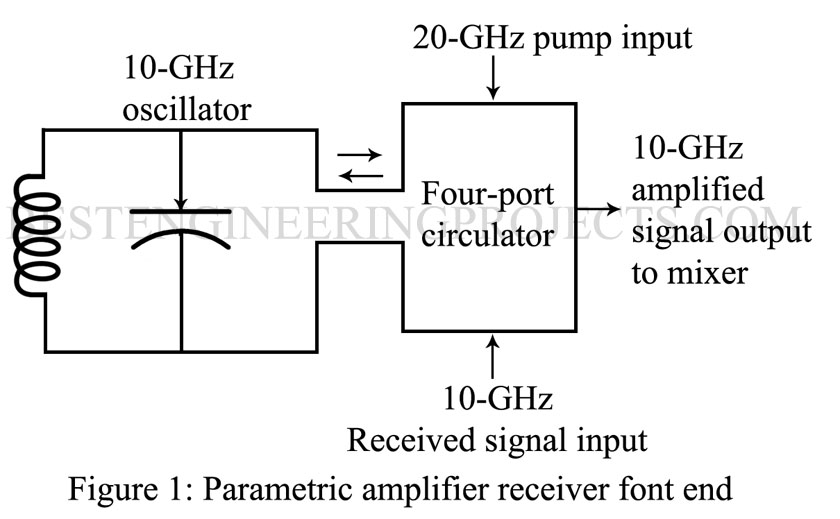A parametric amplifier provides amplification via the variation of a reactance. This reactance is a parameter of a tuned circuit – thus the amplifier’s name. Consider a LC tank circuit that is oscillation at some microwave frequency. If the capacitor’s plates are pulled apart at the instant of time that the voltage across them is maximum positive, work has been accomplished. Since the capacitance, C, has been decreased and the charge, q, must remain the same, the voltage across the capacitor, V, must have been increased since V = q/C. This is the first step in the amplification provided by a parametric amplifier.
Now the plates are returned to their original separation as the oscillator’s signal causes the voltage across the plates to pass through zero. This effort requires no work since now there is no force exerted between the plates. As the voltage across the plates reaches maximum negative, the plates are once again pushed apart, causing the voltage to increase once again. The process is repeated continuously, and amplification has occurred.
The force causing the plates to be pushed apart occurs twice for every cycle of the oscillator’s signal and is called pump source. The pump force is thus a signal at twice the oscillator’s frequency. It is invariably an ac voltage applied to a varactor diode that is part of the oscillator’s tank circuit. The voltage change the capacitance of the diode at just the right time. whereas normally encountered amplifiers provide ac gain with external power obtained from dc source, the parametric amplifier provides ac gain with external power from an ac source at twice the frequency of the signal being amplified.
A simplified 10 10-GHz amplifier is just described is shown in figure 1. Here it is used as the front end (RF stage) of a 10-GHz receiver. As shown, a four-port circulator is required to keep the various signals from interfacing with each other. The low-noise characteristic is the result of amplification via a variable reactance, with the low noise from resistance being almost negligible. These amplifiers are capable of noise figures of 0.3 dB, which is an order of magnitude better than that possible with microwave amplifiers. Power gains of 20 dB are realized.
The noise of microwave systems is often given in terms of noise temperature. This is sometimes a more convenient method of dealing with noise, as the noise temperature of two devices is directly additive. keep in mind, however, that noise temperature, like noise resistance, is simply convenient friction. Noise temperature is related to noise figure (expressed as a ratio and not in decibels) by T = T0(NF-1), where T is noise temperature (K) and T0 is 290 K.
Parametric amplifiers with pump frequencies double the signal frequency are termed as degenerated mode. Parametric amplification is also possible (at reduced gain) with pump frequencies other than 2 times the signal frequency. they are termed the non-degenerated mode. In this case beating between the two frequencies occurs, and a difference signal called idler signal occurs. This mode of operation allows the parametric amplifier to function directly as a mixer, with its output being the first IF frequency.
